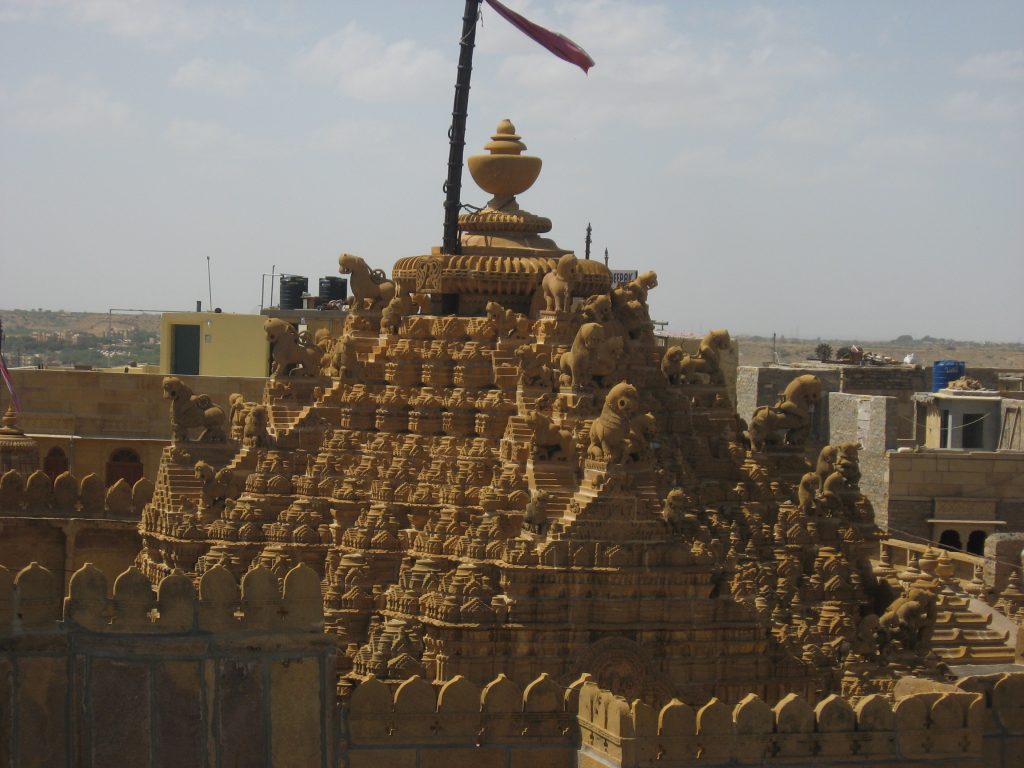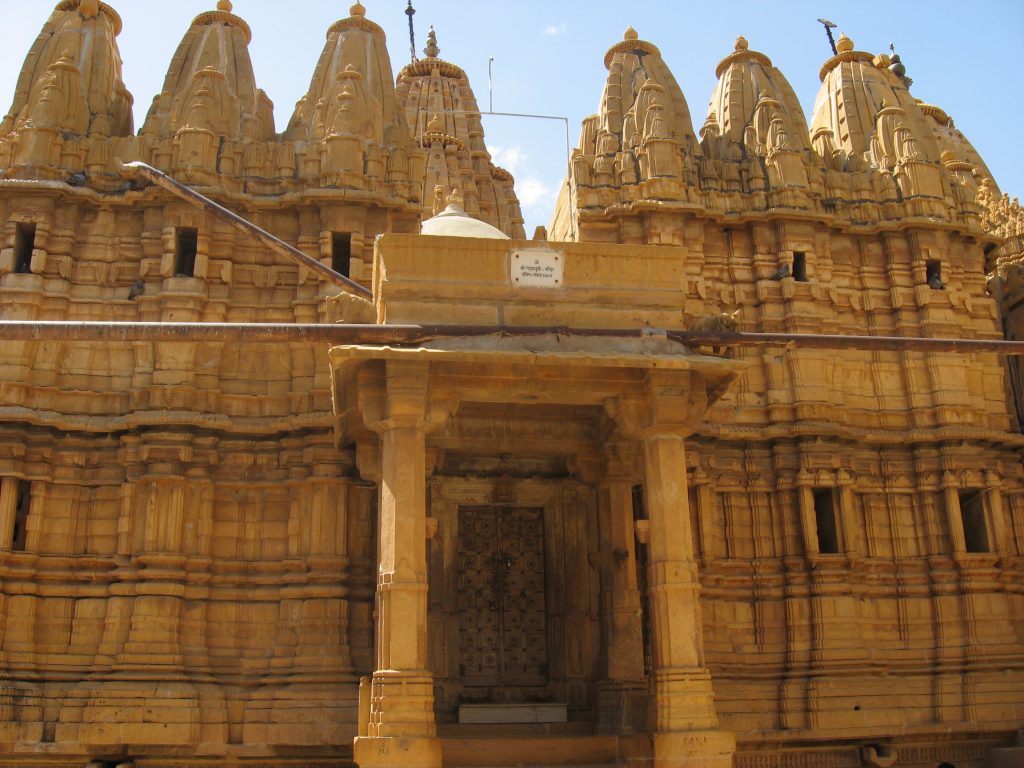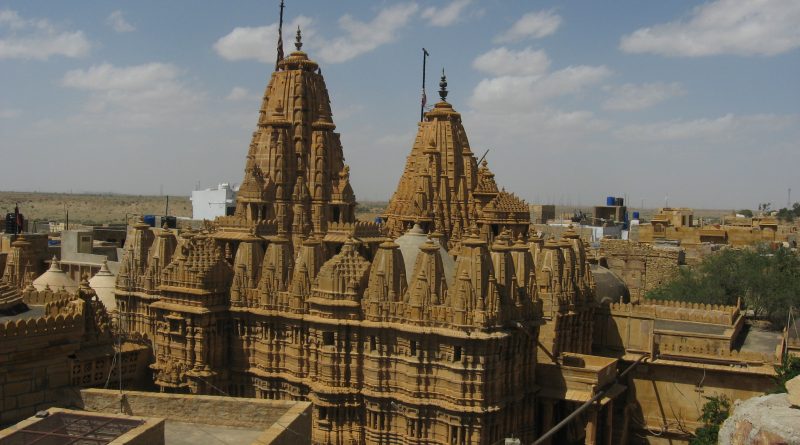The Jain Temples in Jaisalmer

The Gold Fort and the Jain temples
Despite the heat of late March, we go out to explore the Fort deciding not to follow any map. The stone paved streets are neat and crowded with sparrows that fly chirping from one craft shop to another. Small temples overlook narrow squares, where at the end of high steps some gods impersonated by voodoo dolls covered with flowers and red marks look at us with ghostly eyes; next to it in open courtyards undernourished cows rest.
Marco does not resist and buys an orange turban placed in his head by the kind seller; he jumps so joyful with his low Rajasthani pants towards us. It is difficult to resist the impulse to buy those refined bags or voluminous leather notebooks, long colorful shawls among incenses’ smell or the fragrances of spices and fruit; while the locals invite you to enter inside their shops.
The seven Jain temples
Finally we arrive at our first Jain temple, Parshvanath Mandir, one of the largest and oldest (XI century AD). The information I find is not a lot, but religion is very particular. Deities are not transcendent, but part of the world made up of five elements: the living and the non-living (matter, space, movement and rest). Like Buddhism, the monks practice meditation to reach enlightenment and separate themselves from the body, composed of several parts including the karmic body, reaching the Third World where Purity reigns.
The statues inside the Temple do not depict Buddha, but the Tirthamkara, prophets who show the way to enlightenment, carved in shiny white marble in the position of the lotus flower and with a look that bewitches the passerby.
The Parshvanath Mandir, dedicated to the 23rd Tirthamkara, the prophet Parshvanath, is one of the most extended temples. Topped by numerous domes called sikhara (“mountainous peak”) which decrease towards the top in squares of smaller perimeter giving an upward momentum to the building.
From the platform where the temple is located (jagati), the walls have horizontal lines embossed with recesses that are also repeated inside. The style of the architecture is called Dilwara, typical of the medieval period. A series of courtyards leads to the interior rooms where white Tirthankara of different sizes are lined up, all in a lotus flower position.
The greatest beauty of the temple is the complexity of the sculptures present on the numerous columns that form open porticos: statues of sinuous girls, the apsaras, emerge from phytoformed high reliefs which surround entire columns; garlands of flowers with an acute arch connect columns placed at the entrance of the rooms inside, one of which has a dome decorated with statues of sensual dancing girls.
There are seven Jain temples built with yellow sandstone typical of the city and are connected by intricate corridors that we try to cover, finding on the walls some religious references between statues and reliefs. Continuing the exploration we arrive at the smaller Chandraprabhu Temple, dedicated to the eighth eponymous Tithankara, built in the fifteenth century. The external architecture recalls the one described above, but the sikhara are smaller in size.
The interior is gathered around a spherical room embellished by a colonnade connected by garlands in the shape of a pointed arch. From the dome decorated with geometric overhangs and a central rosette emerge statues in pairs of young apsaras with sinuous shapes. Besides, in the small room of the cult reserved for the monks, the bewitched gaze of the white Tithankara in meditation emerges.
On the right is the small Rishabdev temple, dedicated to the eponymous 24th Tithankara, built in the 16th century. The architecture is always in Dilwara style like that of the other temples, with splendid statues of apsaras and divinities protected by glass cases.
Looking for other temples


Behind the Chandraprabhu temple, are located the group of Parsvanath, Shitavath and Kuntanhat temples. The first is connected to the second by a portal to the south. The temple of Shitavath, the tenth of the Tithankara, dedicates the statue to his prophet covered with eight gold plates. The Temple of Khuntanat is more extensive, it has numerous statues of Tithankara in sand color positioned under sandstone canopies decorated with curved garlands. Built in the 12th century as a model of the Hastinapur temple, birthplace of the twelfth prophet.
Nearby is also the last temple, dedicated to Shantinath, built in 1532. Inside are the 24 statues dedicated to the Tithankara.
Going up over the crumbling walls, I admire the roof of one of the temples built with diminishing pyramid-shaped steps; embellished at the corners by sacred monsters similar to the French gargoyles. It is not easy to distinguish one temple from another and memories tend to overlap, given the similarity in style and content.
Tips: the timetable for visiting the temples is restricted from 12:00 to 13:00!


Pingback: Hindu Temples in Kajuraho , western area. - Erica Leoni